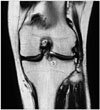Abstract
Materials and Methods
Between March 1998 and October 2004, twenty three patients underwent a meniscal transplant at our institution. Twenty-one out of 23 patients were available for follow-up and were evaluated an average of 44 months (range, 19 to 87 months). Four allografts were medial and 17 were lateral. There were 17 men and 4 women with ages ranging from 16 to 47 years (mean, 29.6 years). The clinical outcomes were evaluated using the Lysholm score, the International Knee Documentation Committee (IKDC) subjective score and the modified Hospital for Special Surgery (HSS) score. MRI and arthroscopic examinations were performed in 18 and 11 patients respectively.
Results
The average Lysholm score improved from 60.6 to 85.7, and that of the IKDC subjective score and modified HSS score (knee score/functional score) was 79.5 and 88/93 respectively. Six of the eleven knees that underwent the arthroscopic examinations were confirmed to be normal. The MRI evaluation revealed all the allografts to have healed completely but there was degeneration/shrinkage of the allografts, and injuries to the surrounding articular cartilage. Extrusion or subluxation of the menisci was observed in all cases.
Conclusion
Meniscal transplantation may be an effective procedure for young and active patients suffering from pain after a meniscectomy with minimal degenerative changes. However, a partial tear, extrusion or subluxation of the allograft menisci and a progression of degenerative arthritis have been reported. Therefore, more accurate and reliable surgical techniques as well as a long-term follow-up are recommended.
Figures and Tables
References
1. Breitenseher MJ, Trattnig S, Dobrocky I, et al. MR imaging of meniscal subluxation in the knee. Acta Radiol. 1997. 38:876–879.

2. Cameron JC, Saha S. Meniscal allograft transplantation for unicompartmental arthritis of the knee. Clin Orthop Relat Res. 1997. 337:164–171.

4. Chen MI, Branch TP, Hutton WC. Is it important to secure the horns during lateral meniscal transplantation? A cadaveric study. Arthroscopy. 1996. 12:174–181.

6. Crues JV 3rd, Mink J, Levy TL, Lotysch M, Stoller DW. Meniscal tears of the knee: accuracy of MR imaging. Radiology. 1987. 164:445–448.

7. Crues JV, Stoller DW. Mink JH, Reicher MA, Creus JV, Deuttsch AL, editors. The menisci. Magnetic resonance imaging of the knee. 1992. New York: Raven;91–136.
9. Fairbanks TJ. Knee joint changes after meniscectomy. J Bone Joint Surg Br. 1948. 30:664–670.
10. Fukubayashi T, Kurosawa H. The contact area and pressure distribution pattern of the knee. Acta Orthop Scand. 1980. 51:871–879.
11. Garrett JC. Meniscal transplantation: a review of 43 cases with two to seven year follow-up. Sports Med Arthrosc Rev. 1993. 1:164–167.
12. Hayes CW, Conway WF. Evaluation of articular cartilage: radiographic and cross-sectional imaging techniques. Radiographics. 1992. 12:409–428.

13. Henning CE, Lynch MA. Current concepts of meniscal function and pathology. Clin Sports Med. 1985. 4:259–265.
14. King D. The healing of semilunar cartilages. 1936. Clin Orthop Relat Res. 1990. 252:4–7.
15. Kurosawa H, Fukubayashi T, Nakajima H. Load-bearing mode of the knee joint: physical behavior of the knee joint with or without menisci. Clin Orthop Relat Res. 1980. 149:283–290.
16. Lanzer WL, Komenda G. Changes in articular cartilage after meniscectomy. Clin Orthop Relat Res. 1990. 252:41–48.

17. Levy IM, Torzilli PA, Warren RF. The effect of medial meniscectomy on anterior-posterior motion of the knee. J Bone Joint Surg Am. 1982. 64:883–888.

18. McGinity JB, Geuss LF, Marvin RA. Partial or total meniscectomy: a comparative analysis. J Bone Joint Surg Am. 1977. 59:763–766.
19. Milachowski KA, Weismeier K, Wirth CJ. Homologous meniscus transplantation. Experimental and clinical results. Int Orthop. 1989. 13:1–11.
20. Morgan CD, Wojtys EM, Casscells CD, Casscells SW. Arthroscopic meniscal repair evaluated by second-look arthroscopy. Am J Sports Med. 1991. 19:632–637.

21. Northmore-Ball MD, Dandy DJ, Jackson RW. Arthroscopic, open partial, and total meniscectomy. A comparative stydy. J Bone Joint Surg Br. 1983. 65:400–404.
22. Noyes FR, Barber-Westin SD. Irradiation meniscus allografts in the human knee: a two to five year follow-up study. Orthop Trans. 1995. 19:417.
23. Outerbridge RE. The etiology of chondromalacia patellae. J Bone Joint Surg Br. 1961. 43:752–757.

25. Peterfy CG, Majumdar S, Lang P, van Dijke CF, Sack K, Genant HK. MR imaging of the arthritic knee; improved discrimination of cartilage, synovium, and effusion with pulsed saturation transfer and fat-suppressed T1-weighted sequences. Radiology. 1994. 191:413–419.

26. Potter HG, Rodeo SA, Wickiewicz TL, Warren RF. MR imaging of meniscal allografts: correlation with clinical and arthroscopic outcomes. Radiology. 1996. 198:509–514.

27. Quinn SF, Brown TF. Meniscal tears diagnosed with MR imaging versus arthroscopy; how reliable a standard is arthroscopy? Radiology. 1991. 181:843–847.

28. Rath E, Richmond JC, Yassir W, Albright JD, Gundogan F. Meniscal allograft transplantation. Two- to eight-year results. Am J Sports Med. 2001. 29:410–414.
29. Recht MP, Resnick RJ. MR imaging of articular cartilage: current status and future directions. AJR Am J Roentgenol. 1994. 163:283–290.

30. Renstrom P, Johnson RJ. Anatomy and biomechanics of the menisci. Clin Sports Med. 1990. 9:523–538.
31. Rodeo SA. Meniscal allograft: where do we stand? Am J Sports Med. 2001. 29:246–261.
32. Staubli HU, Birrer S. The popliteus tendon and its fascicles at the popliteal hiatus: gross anatomy and functional arthroscopic evaluation with and without anterior cruciate ligament deficiency. Arthroscopy. 1990. 6:209–220.
33. Stollsteimer GT, Shelton WR, Dukes A, Bomboy AL. Meniscal allograft transplantation: a 1- to 5-year follow-up of 22 patients. Arthroscopy. 2000. 16:343–347.

34. van Arkel ER, Goei R, de Ploeg I, de Boer HH. Meniscal allografts: evaluation with magnetic resonance imaging and correlation with arthroscopy. Arthroscopy. 2000. 16:517–521.

35. Verdonk P, Depaepe Y, Desmyter S, et al. Normal and transplanted lateral knee menisci: evaluation of extrusion using magnetic resonance imaging and ultrasound. Knee Surg Sports Traumatol Arthrosc. 2004. 12:411–419.

36. Voloshin AS, Wosk J. Shock absorption of meniscectomized and painful knees; a comparative in-vivo study. J Biomed Eng. 1983. 5:157–161.




 PDF
PDF ePub
ePub Citation
Citation Print
Print




 XML Download
XML Download